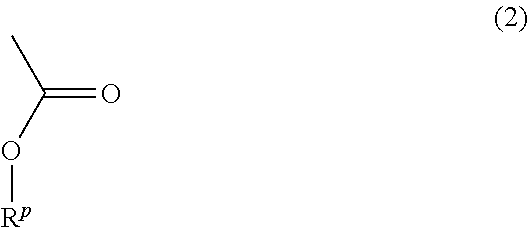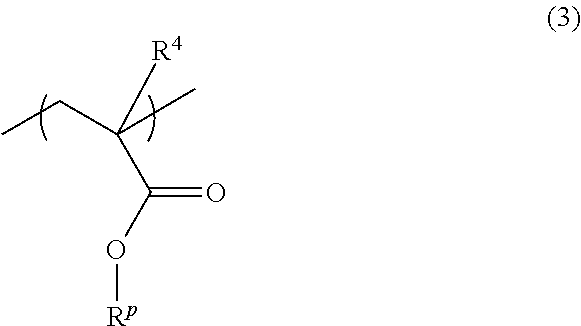Method for forming pattern and developer
a technology of pattern and developer, applied in the field of pattern forming method and developer, can solve the problems of difficult to form fine resist patterns, and achieve the effects of excellent resist patterns, reduced solubility of polymer (a) in the negative developer that includes the organic solvent, and reduced solubility of the polymer (a) in the developer
- Summary
- Abstract
- Description
- Claims
- Application Information
AI Technical Summary
Benefits of technology
Problems solved by technology
Method used
Image
Examples
synthesis example 1
[0166]43.08 g (50 mol %) of the compound (M-1) and 56.92 g (50 mol %) of the compound (M-5) were dissolved in 200 g of 2-butanone. 4.21 g (5 mol % based on the total amount of the monomer compounds) of AIBN was added to the solution to prepare a monomer solution. A three-necked flask (1000 ml) charged with 100 g of 2-butanone was purged with nitrogen for 30 minutes, and heated to 80° C. with stirring. The monomer solution was added dropwise to the flask using a dropping funnel over 3 hours. The monomers were polymerized for 6 hours from the start of addition of the monomer solution. After completion of polymerization, the polymer solution was cooled with water to 30° C. or less. The cooled polymer solution was added to 2000 g of methanol, and a precipitated white powder was collected by filtration. The white powder thus collected was washed twice with 400 g of methanol, collected again by filtration, and dried at 50° C. for 17 hours to obtain a white powdery polymer (A-1) (73 g, yie...
synthesis examples 2 to 4
[0167]Polymers (A-2) to (A-4) were produced in the same manner as in Synthesis Example 1, except for using the monomers shown in Table 1. The content of each structural unit, the Mw, the Mw / Mn ratio, the yield, and the content of low-molecular-weight components of (in) each polymer are also shown in Table 1.
synthesis example 5
[0168]71.67 g (70 mol %) of the compound (M-9) and 28.33 g (30 mol %) of the compound (M-11) were dissolved in 100 g of 2-butanone. 10.35 g of dimethyl-2,2′-azobisisobutyrate was added to the solution to prepare a monomer solution. A three-necked flask (1000 ml) charged with 100 g of 2-butanone was purged with nitrogen for 30 minutes, and heated to 80° C. with stirring. The monomer solution was added dropwise to the flask using a dropping funnel over 3 hours. The monomers were polymerized for 6 hours from the start of addition of the monomer solution. After completion of polymerization, the polymer solution was cooled with water to 30° C. or less. The polymer solution was put in a 4 l separating funnel, and homogeneously diluted with 300 g of n-hexane. After the addition of 1200 g of methanol, the components were mixed. After the addition of 60 g of distilled water, the mixture was stirred, and allowed to stand for 30 minutes. The lower layer was collected, and dissolved in propylen...
PUM
| Property | Measurement | Unit |
|---|---|---|
| width | aaaaa | aaaaa |
| thickness | aaaaa | aaaaa |
| thickness | aaaaa | aaaaa |
Abstract
Description
Claims
Application Information
 Login to View More
Login to View More - R&D
- Intellectual Property
- Life Sciences
- Materials
- Tech Scout
- Unparalleled Data Quality
- Higher Quality Content
- 60% Fewer Hallucinations
Browse by: Latest US Patents, China's latest patents, Technical Efficacy Thesaurus, Application Domain, Technology Topic, Popular Technical Reports.
© 2025 PatSnap. All rights reserved.Legal|Privacy policy|Modern Slavery Act Transparency Statement|Sitemap|About US| Contact US: help@patsnap.com



